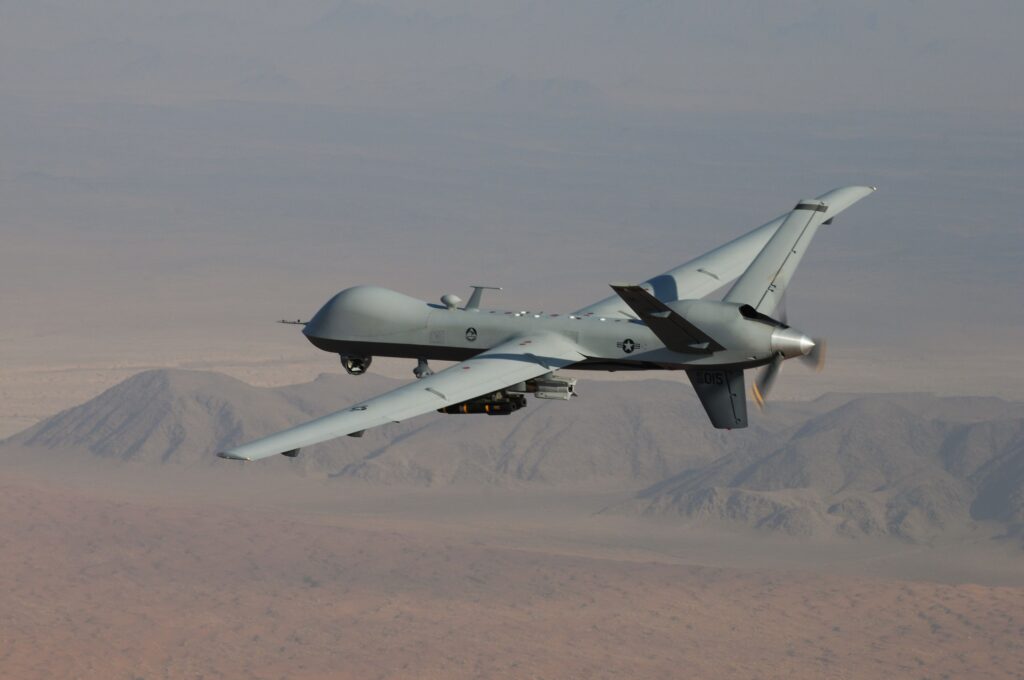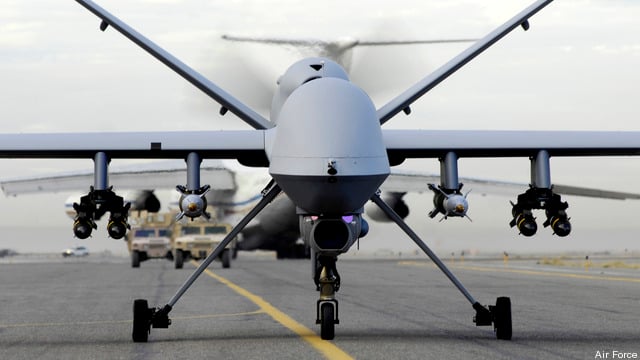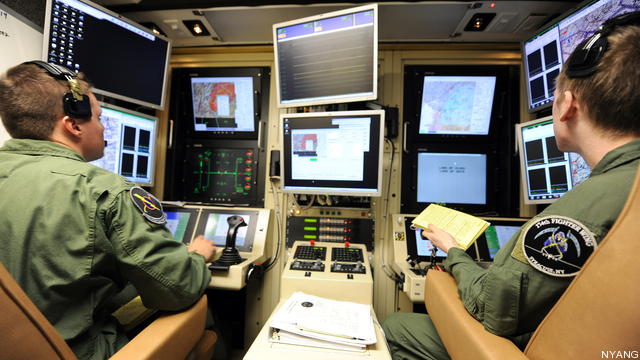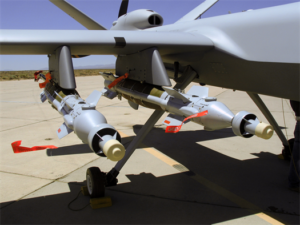
MQ-9 Reaper in flight
These days, it’s rare that American military operations around the world end in bloody battles with scores of casualties. It is not because we have brought all of the troops home – far from it: There are over 170,000 active duty personnel serving around the world. It is not because we are a “great power in decline,” as some might claim: Our military still serves as a vital check to the malign ambitions of regional powers to include China, Iran, and Russia.
The news about our military has gotten better because our military has gotten better—and one technology in particular, our drones, has boosted American military efficiency and effectiveness. But now the star of that program, the MQ-9 Reaper, is under the knife in the Air Force’s 2021 budget plan, which would reduce funding for Reaper patrols and stop buying new MQ-9s altogether.
Key committees in Congress seek to restore funding, but they all come in at different amounts. While the Air Force asked for a mere $29.5 million, just enough to close down the production line. House appropriators proposed $344 million for 16 new drones, Senate authorizers added $170.6 million, and House authorizers added $108 million. Senate appropriators have not yet acted. The final figure is far from settled and could easily be caught up in end-of-year gridlock and veto threats.
Underfunding the Reaper program would disrupt one of America’s military asymmetric advantages—the strength of our drone force. As security challenges to our nation and its allies are surging, this is not the time to shrink the MQ-9 fleet or cut back on Reaper flights.

Armed MQ-9 Reaper drone.
Quietly and behind the scenes, our drone program helps our soldiers, sailors, airman, and marines avoid catastrophic roadside bomb attacks, keeps vital shipping channels free of mines and enemy combatants, strikes high-value terrorist targets, and accomplishes what previously was thought to be next to impossible: tracking our enemies’ movements day and night with extraordinary precision.
More than any other factor, it is our drone missions that have kept the Taliban at bay in Afghanistan — without the kind of deadly headlines that can result when our men and women in uniform are put in harm’s way. It is therefore puzzling that the Department of Defense wants to scale back MQ-9 operations. In its Fiscal Year 2021 submission to Congress, the Air Force chose to cut MQ-9 Reaper combat air patrols (CAPS) from 70 to 60.
Now, it might make some sense to cut the CAPS operated by military personnel, as a recent GAO report states, “The Air Force does not have enough pilots and sensor operators to meet its staffing targets for its unmanned aircraft.” However, the proposed cuts are for contractor-operated CAPS. Using contractor-operated MQ-9s provides a level of flexibility that DoD-operated CAPS do not; reducing only contractor CAPs will effectively eliminate the nation’s surge capacity and negatively impact future reaction capabilities.
When this news was first released, commanders around the world spoke out forcefully against the plan. Gen. Ken McKenzie, commander of U.S. Central Command, called the MQ-9 air patrols a “genuine requirement” that give the U.S. “intelligence-gathering capabilities we might not otherwise have.” Gen. Steve Townsend, the head of U.S. Africa Command, echoed those sentiments, arguing that the MQ-9 drones are important for his efforts against ISIS-affiliates in far-flung areas across the African continent.

Air Force MQ-9 Reaper operators in training.
The Air Force’s rationale is that they want to invest in higher-tech weapons of the future and eventually retire the MQ-9. With the smallest budget of the three US military departments, the Air Force has been issued more mission requirements than it has been given resources to accomplish. Therefore, as a result of the stovepiped manner in which the Pentagon does budgeting—by service departments rather than combatant command needs—the Air Force is put into the position of having to cut its roughly 300 current drones in order to get even better drones in the future.
As the world’s sole superpower, we can and should fund both, because these platforms are extraordinarily cost-effective relative to systems that the Pentagon has in excessive numbers and which see much less use, such as the Army’s roughly 1,000 Apache attack helicopters and 6,000 M1 tanks. Yes, Russia, China, and the countries that buy from them are deploying ever more effective anti-aircraft systems, and the MQ-9 is not a stealth aircraft – but there are still plenty of places around the world where a Reaper can fly safely while ground troops would face grave danger. Even against a heavily armed adversary, U.S. air doctrine would use stealth strikes to rip holes in air defenses that allow other aircraft to move through, giving the MQ-9 a role even in great power conflict.
The proposed drone cuts also come when countries around the world are “droning up.” Just in the last several weeks, we’ve seen news of Turkey building “suicide” drones; India buying up leading drone technology; Russia’s top defense provider joining the drone business; and Israel’s creation of “counter-drone” technology. All of that comes amid a global pandemic that has absorbed the attention of the leaders of those countries. Those developments illustrate how important drone technology has become—not to just the U.S. but to both friends and foes across the globe.

Reaper drone with GBU-38
With the commanders who are responsible for combat mission accomplishment highlighting the vital importance of drone resources, with our allies and adversaries deploying these technologies left and right, and with a White House eager to avoid sending America’s sons and daughters into harm’s way, there is little mission justification for reducing the deployed orbits of the highly valued MQ-9.
There is even less justification when considering the over 1,000 private sector jobs—many held by U.S. military veterans—that will be lost in the midst of our national recession if the current number of contractor-operated MQ-9 combat lines are cut. At a time of jaw-dropping unemployment, it seems unwise that the Pentagon would make it worse.
The best rationale in favor of the MQ-9 program, however, is the simplest: these drones patrol the darkest, most dangerous corners of the globe, and because they do, drones keep young American men and women out of danger. When a drone can surveil a patch of desert in Africa’s Sahel hotbed, fewer American men and women need to don night-vision goggles and do the same. If a drone can eliminate a high-value target in the mountainous region of Afghanistan, that means fewer U.S. personnel and support assets are put at risk.
As a former joint task force commander tasked with the welfare of American service members, I held my breath every time they went into harm’s way. Commanders do not want their orders to result later in a call to their families with grim news. The MQ-9 program has reduced the number of those phone calls—and increased American military effectiveness over the last decade. That is the reason to keep the MQ-9 program going in the near-term: It has saved and will continue to save the lives of U.S. military personnel while attaining our military objectives.
As our Central Command combatant commander has requested as his number one unfunded priority, the Congress should take action to keep the MQ-9 program at current operating levels – and to avoid a repeat of this predicament in the future, the Pentagon needs to start funding the Air Force to do all the missions that it’s required to do.

David Deptula
David A. Deptula is a retired Air Force Lt. General with over 3,000 flying hours in F-15 fighters and other aircraft. He planned the Desert Storm air campaign, orchestrated air operations over Iraq and Afghanistan, oversaw the largest increase in drone operations in Air Force history, and is now dean of the Mitchell Institute for Aerospace Studies.
Lockheed Martin projects potential $1 billion loss on classified program
Lockheed CFO Jay Malave said the company currently expects the program to become profitable on an annual basis around the 2028 timeframe.


























